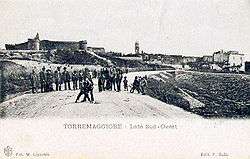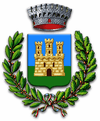Torremaggiore
| Torremaggiore | ||
|---|---|---|
| Comune | ||
| Comune di Torremaggiore | ||
|
Old postcard of Torremaggiore, ducal castle to the left | ||
| ||
 Torremaggiore Location of Torremaggiore in Italy | ||
| Coordinates: 41°41′N 15°17′E / 41.683°N 15.283°E | ||
| Country | Italy | |
| Region | Apulia | |
| Province / Metropolitan city | Foggia (FG) | |
| Government | ||
| • Mayor | Costanzo Di Iorio (PD) | |
| Area | ||
| • Total | 208 km2 (80 sq mi) | |
| Elevation | 169 m (554 ft) | |
| Population (1 August 2009) | ||
| • Total | 17,307 | |
| • Density | 83/km2 (220/sq mi) | |
| Demonym(s) | Torremaggioresi | |
| Time zone | CET (UTC+1) | |
| • Summer (DST) | CEST (UTC+2) | |
| Postal code | 71017 | |
| Dialing code | 0882 | |
| Patron saint | St. Sabinus Bishop | |
| Saint day | First Sunday in June | |
| Website | Official website | |
Torremaggiore is a town and comune in the province of Foggia in the Apulia region of southeast Italy.
It includes the Diocese of Dragonara, the episcopal see of a former medieval residential diocese and present Latin Catholic titular bishopric.
It lies on a hill, 169 metres (554 ft) over the sea, and is famous for production of wine and olives.
History
The history of Torremaggiore is strictly connected to that of the burg of Fiorentino (also Castel Fiorentino), a Byzantine frontier stronghold founded by the catepan Basil Boioannes in 1018. Later a Norman, Hohenstaufen, Angevine and finally Aragonese possession, it is especially remembered as the death place of Holy Roman Emperor Frederick II (December 13, 1250).
Five years later the burg was attacked by Pope Alexander IV's troops, and the inhabitants fled to a nearby Benedictine abbey. Later they were allowed to found a new settlement, called Codacchio, later, when other refugees from Dragonara arrived, christened Terra Maioris ("Major Land"), the modern Torremaggiore. This burg was later a fief of the counts of Sangro. It was destroyed by an earthquake on July 30, 1627. On March 17, 1862 a platoon of royal troops was defeated by the brigands of Carmine Crocco; 21 soldiers were killed, even their captain Francesco Richard.
From August 25, 1925 Torremaggiore was connected to the nearby San Severo by a tramway, the first in southern Italy.
Main sights
- The Castle of the Dukes of Sangro, built from a Norman tower, has maintained the Renaissance appearance. It includes four circular and two square towers, and a throne hall with a 17th-century fresco frieze. It is home to the archaeological exhibition of findings from Fiorentino.
- Chiesa matrice di San Nicola ("Mother Church of St. Nicholas", 13th century), built by the refugees from Fiorentino and Dragonara. It was rebuilt in 1631 after the earthquake.
- Church of Santa Maria della Strada (early 16th century).
- Sanctuary of Santa Maria della Fontana.
- Church of the Madonna di Loreto (16th century), erected by Albanian immigrants. It was rebuilt in 1627.
- Church of Santa Maria degli Angeli (17th century).
- Castle of "Fiorentino" (11th century), place of death of Emperor Frederick II.
- Castle of "Dragonara" (11th century).
People
- Rogerius of Apulia (c.1205–1266), medieval Roman Catholic monk and chronicler
- Luigi Rossi (1597–1653), musician
- Raimondo di Sangro (1710–1771), prince and scientist
- Nicola Fiani (1757–1799), patriot and radical, executed after the collapse of the Parthenopean Republic[1]
- Fortune Gallo (1878–1970), opera impresario
- Nicola Sacco (1891–1927), anarchist, executed following a controversial American trial
Twinned cities
-
 Buffalo, NY, United States
Buffalo, NY, United States -

 Canosa di Puglia, Barletta-Andria-Trani, Apulia, Italy
Canosa di Puglia, Barletta-Andria-Trani, Apulia, Italy -

 Villafalletto, Cuneo, Piedmont, Italy
Villafalletto, Cuneo, Piedmont, Italy
References
- ↑ ‘Chi era Nicola Fiani?’, Liceo Ginnasio Statale “N. Fiani”, Torremaggiore.

